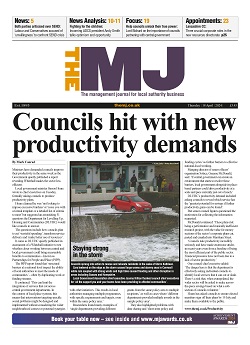Woking, South Norfolk and Craven DCs are likely to be the hardest hit when it comes to lost income.
The three councils top the list of districts when it comes to the ratio of income from fees and charges against their service expenditure, and are likely to suffer from a loss of income from services such as parking and leisure while the public is in lockdown.
Figures from the Chartered Institute of Public Finance and Accountancy’s resilience index give an indicator of how reliant councils were on income from fees and charges last year.
Those authorities with a high percentage of their income generated locally – as the Government encouraged them to do – were seen as ‘low risk’ as they were less reliant on fluctuations in central Government grants.
However, those ‘low risk’ authorities are now exposed to a sharp downturn in income as the public is forced to steer clear of town centres and attractions, and as development stalls.
Woking’s finance director, Leigh Clarke, said the council had a ‘positive programme of investment, earning rental income to support services. ‘Clearly with coronavirus, a proportion of this income is at risk,’ she said.
‘Providing some degree of normality returns during the second half of the financial year, a combination of support offered by Government, the use of some reserves and, hopefully, with Government permission, the capitalisation of any significant deficit, will avoid the need for service reduction.’
Leader of South Norfolk DC, Cllr John Fuller, told The MJ: ‘Taking a lead from successive Governments we have pivoted our council to generate significant income from trading.’
For his authority, the income includes money from leisure provision and house building.
He added: ‘We are engaging on an in-year re-budgeting exercise as well as recasting our medium-term financial plan with a background of significant reserves to allow us to ride the crisis.’
Craven DC chief executive, Paul Shevlin, said: ‘District councils have been the most severely affected by cuts in Government funding over the last 10 years, and we have also been very badly affected by the current crisis.
‘While the council is suffering due to this loss in income, we are determined to continue serving our residents.’ Other types of authority are less exposed.
The London boroughs with the largest proportion of income from fees and charges to expenditure ratio are Kensington & Chelsea LBC (35%), Westminster City Council (28%) and the City of London Council (25%). Of the counties, Staffordshire CC (15%) and Northamptonshire CC (12%) will be hardest hit, but face few losses compared with districts.
Ratio of fees and charges to service expenditure
| Authority | % |
|
Woking BC |
70.32 |
|
South Norfolk DC |
64.73 |
|
Craven DC |
51.16 |
|
Wycombe DC |
50.2 |
|
Mole Valley DC |
48.05 |
|
North East Derbyshire DC |
47.45 |
|
Kings Lynn & West Norfolk BC |
45.64 |
|
Horsham DC |
43.49 |
|
West Dorset DC* |
43.36 |
|
New Forest BC |
43.2 |

